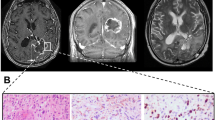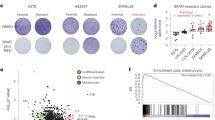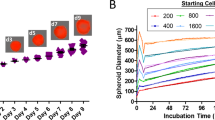Abstract
To validate the use of multicellular spheroids to predict the efficacy of herpes simplex thymidine kinase/ganciclovir (HSVtk/GCV) suicide gene therapy in the respective in vivo tumors, we established and characterized 15 melanoma-derived cell lines from surgically excised melanoma tumors. Three HSVtk-lipofected cell lines were not sensitive to GCV in any culture configuration, other five displayed similar sensitivity as monolayers or spheroids, and only one resulted more sensitive when grown as spheroids. Other six cell lines manifested a relative multicellular resistance (MCR) phenotype growing as spheroids, compared with the same cells growing as monolayers. The reverse correlation between the MCR and the monolayers survival to HSVtk/GCV suggests that one of the main causes of MCR would be the rapid cell repopulation after suicide gene treatment. The high correlation of MCR with the spheroids radial growth and with the mitotic index of the respective originary tumors supported this re-growth involvement. A remarkable finding was the high correlation in HSVtk/GCV sensitivity between in vivo tumor and the corresponding derived cell lines growing as spheroids (R2=0.85). This strongly encourages the implementation of spheroids as highly realistic experimental model for optimizing and predicting the in vivo response of the respective tumors to therapeutic strategies.
This is a preview of subscription content, access via your institution
Access options
Subscribe to this journal
Receive 12 print issues and online access
$259.00 per year
only $21.58 per issue
Buy this article
- Purchase on Springer Link
- Instant access to full article PDF
Prices may be subject to local taxes which are calculated during checkout








Similar content being viewed by others
References
Ramos-Vara JA, Beissenherz ME, Miller MA, Johnson GC, Pace LW, Fard A et al. Retrospective study of 338 canine oral melanomas with clinical, histologic, and immunohistochemical review of 129 cases. Vet Pathol 2000; 37: 597–608.
Smith SH, Goldschmidt MH, McManus PM . A comparative review of melanocytic neoplasms. Vet Pathol 2002; 39: 651–678.
Finocchiaro LME, Fiszman GL, Karara AL, Glikin GC . Suicide gene and cytokines combined non viral gene therapy for canine spontaneous melanoma. Cancer Gene Ther 2008; 15: 165–172.
Finocchiaro LME, Glikin GC . Cytokine-enhanced vaccine and suicide gene therapy as surgery adjuvant treatments for spontaneous canine melanoma. Gene Therapy 2008; 15: 267–276.
Altamirano NA, Karara AL, Villaverde MS, Fiszman GL, Glikin GC, Finocchiaro LME (2007). Spontaneous canine melanoma derived spheroids display individual multicellular resistance patterns to suicide gene and chemotherapy. In: Torres LS (ed). Cancer Drug Resistance Research Perspectives. Nova Science Publishers, Inc.: New York., pp 119–137, ISBN: 1-60021-572-6.
Mesnil M, Yamasaki H . Bystander effect in herpes simplex virus-thymidine kinase/ganciclovir cancer gene therapy: role of gap-junctional intercellular communication. Cancer Res 2000; 60: 3989–3999.
Desoize B, Jardillier JC . Multicellular resistance: a paradigm for clinical resistance? Crit Rev Oncol Hematol 2000; 36: 193–207.
Santini MT, Rainaldi G . Three-dimensional spheroid model in tumor biology. Pathobiology 1999; 67: 148–157.
Sutherland RM . Cell and environment interactions in tumor microregions: the multicell spheroid model. Science 1998; 240: 177–184.
Finocchiaro LME, Bumaschny VF, Karara AL, Fiszman GL, Casais CC, Glikin GC . Herpes simplex virus thymidine kinase/ganciclovir system in multicellular tumor spheroids. Cancer Gene Ther 2004; 11: 333–345.
Karara AL, Bumaschny VF, Fiszman GL, Casais CC, Glikin GC, Finocchiaro LM . Lipofection of early passages of cell cultures derived from murine adenocarcinomas: in vitro and ex vivo testing of the thymidine kinase/ganciclovir system. Cancer Gene Ther 2002; 8: 96–99.
MacGregor GR, Caskey T . Construction of plasmids that express E coli β-galactosidase in mammalian cells. Nucleic Acids Res 1989; 17: 2365–2365.
Felgner JH, Kumar R, Sridhar CN, Wheeler CJ, Tsai YJ, Border R et al. Enhanced gene delivery and mechanism studies with a novel series of cationic lipid formulations. J Biol Chem 1994; 269: 2550–2561.
Gao X, Huang L . Cationic liposome-mediated gene transfer. Gene Therapy 1995; 2: 710–722.
Casais CC, Karara AL, Glikin GC, Finocchiaro LME . Effects of spatial configuration on tumor cells transgene expression. Gene Ther Mol Biol 2006; 10: 207–222.
Inoue K, Ohashi E, Kadosawa T, Hong SH, Matsunaga S, Mochizuki M et al. Establishment and characterization of four canine melanoma cell lines. J Vet Med Sci 2004; 66: 1437–1440.
Hendrix MJ, Seftor EA, Chu YW, Seftor RE, Nagle RB, McDaniel KM et al. Coexpression of vimentin and keratins by human melanoma tumor cells: correlation with invasive and metastatic potential. J Natl Cancer Inst 1992; 84: 165–174.
Koenig A, Wojcieszyn J, Weeks BR, Modiano JF . Expression of S100a, vimentin, NSE, and melan A/MART-1 in seven canine melanoma cells lines and twenty-nine retrospective cases of canine melanoma. Vet Pathol 2001; 38: 427–435.
Mueller-Klieser W . Tumor biology experimental therapeutics. Critical Rev Oncol Hematol 2000; 36: 123–139.
Brown JM, Giaccia AJ . The unique physiology of solid tumors: opportunities (and problems) for cancer therapy. Cancer Res 1998; 58: 1408–1416.
Siemann DW . The tumor microenvironment: a double-edged sword. Int J Radiat Oncol Biol Phys 1998; 42: 697–699.
Spangler WL, Kass PH . The histologic and epidemiologic bases for prognostic considerations in canine melanocytic neoplasia. Vet Pathol 2006; 43: 136–149.
Acknowledgements
We thank Graciela Zenobi for technical assistance, Lina Marino for expert immunocytochemical analysis and María D Riveros and Dr Armando L Karara for their contribution in the early stages of this study. This study was partially supported by a grant from ANPCYT-FONCYT: BID1728/OC-AR—PICT 2002—12084 and PID-UBACYT-2008/2010—M027. G.C.G. and L.M.E.F. are investigators, and M.L.G.C. and M.S.V. are fellows of the Consejo Nacional de Investigaciones Científicas y Técnicas (CONICET, Argentina).
Author information
Authors and Affiliations
Corresponding author
Rights and permissions
About this article
Cite this article
Gil-Cardeza, M., Villaverde, M., Fiszman, G. et al. Suicide gene therapy on spontaneous canine melanoma: correlations between in vivo tumors and their derived multicell spheroids in vitro. Gene Ther 17, 26–36 (2010). https://doi.org/10.1038/gt.2009.107
Received:
Revised:
Accepted:
Published:
Issue Date:
DOI: https://doi.org/10.1038/gt.2009.107
Keywords
This article is cited by
-
Particulate mediators of the bystander effect linked to suicide and interferon-β transgene expression in melanoma cells
Gene Therapy (2021)
-
Combination of cytokine-enhanced vaccine and chemo-gene therapy as surgery adjuvant treatments for spontaneous canine melanoma
Gene Therapy (2019)
-
Multicellular Tumor Spheroids as a Model for Assessing Delivery of Oligonucleotides in Three Dimensions
Molecular Therapy - Nucleic Acids (2014)
-
Interferon-β lipofection II. Mechanisms involved in cell death and bystander effect induced by cationic lipid-mediated interferon-β gene transfer to human tumor cells
Cancer Gene Therapy (2012)
-
Interferon-β lipofection I. Increased efficacy of chemotherapeutic drugs on human tumor cells derived monolayers and spheroids
Cancer Gene Therapy (2012)



